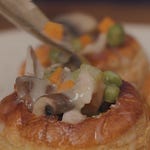I know you probably think its too early for holiday recipes but Turkey day is a little more than a month away If there's one dish that can make potatoes go from humble to haute cuisine, it’s pavé potatoes. You may have seen them called "15-hour potatoes" or "thousand-layer potatoes" on Instagram, or maybe you've encountered a more refined description in a Michelin-starred restaurant. Regardless of what you call them, one thing is certain: these potatoes are pure perfection.
At first glance, you might think, "They're just layered potatoes, right?" But oh, they're so much more than that. The beauty of pavé potatoes lies in their precision. Thinly sliced potatoes are stacked meticulously, bathed in ghee pressed into an even block, and slow-cooked until they achieve a texture that can only be described as ethereal. After chilling overnight, the magic happens: they're cut into perfect squares and fried until the edges are golden and crispy. The result is a potato dish that’s crispy on the outside, creamy and tender inside, with each layer whispering sweet potato nothings.
Some might argue butter is enough. And sure, butter is nice, but duck fat? Duck fat is that extra little nudge toward decadence. It adds a rich, savory depth that complements the creamy potato interior and gives the exterior an irresistible crunch. When you fry the pavé squares in duck fat, you get that extra level of bougie that butter alone just can’t deliver.
Potato Pavé
3 lbs of russet potatoes, sliced 1/8 inch thick on a mandoline
1/2 cup ghee melted
Kosher salt to taste
Duck fat for frying
(Preheat oven to 300 degrees)
1. Grab your mandoline and slice the potatoes thinly 1/8 inch. This is where that "thousand-layer" name comes from. You’re aiming for slices so thin you could almost read a book through them (okay, maybe not quite, but you get the idea). Toss the slices in the ghee and make sure they are evenly coated
2. Line a loaf pan with parchment and shingle the potatoes so that they resemble fish scales, gently overlapping. I sometimes go in opposite directions like a cross hatch for stability when frying.
3. Cover with parchment and seal tightly with foil. Bake 2 1/2 hours until a toothpick easily inserts to the bottom.
4. From the oven remove the foil, and place another loaf pan weighted with a few cans and place in the fridge overnight to set. At this point your could freeze for up to a month and fry later.
5. Heat the duck fat to 375 degrees. Fry until golden brown about 5-6 minutes.
6. Finish with a sprinkle of sea salt and watch as these beauties disappear from the plate.
The brilliance of pavé potatoes is in the contrast: soft, melt-in-your-mouth layers inside, wrapped in an audibly crisp exterior. The combination of technique and time transforms something simple into a side dish that could steal the show from even the most carefully cooked main course. Whether you're serving these alongside a steak, with some roasted chicken, or just as the star of your next dinner party, they'll never fail to impress.
Plus, let's be honest: anything that involves a generous helping of duck fat automatically qualifies as next-level indulgence.
Pavé potatoes are the kind of dish that makes you realize just how glorious potatoes can be. So whether you're calling them 15-hour potatoes, thousand-layer potatoes, or just the best damn potatoes you’ve ever had, one thing’s for sure—they're an absolute must-try. And with duck fat in the mix? It's game over.












Share this post